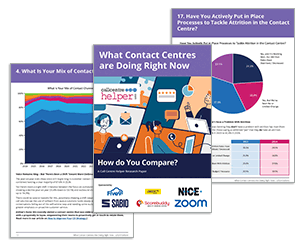Meta’s recent announcements have left many feeling confused about their future use of WhatsApp, Instagram and Facebook – not only in their personal lives, but also about using them in their contact centres.
So, now what? Our Editor, Megan Jones, takes a closer look at what’s happening and how contact centre leaders could respond.
What’s Happening at Meta?
In short, Meta has announced it is getting rid of fact-checking and loosening its rules around what people can say in its apps.
As confirmed in this news report:
“Meta is specifically moving to allow more kinds of speech on topics “that are frequently subject to political debate”, beginning with discussion related to immigration and gender identity. In Meta’s updated moderation guidelines, characterizations and comments that had been against its rules will now be acceptable.”
[Note – Call Centre Helper does not wish to republish or be associated with the types of comments that will now be acceptable on these platforms, but you can look these up for yourself here if you wish.]
Contact Centres Have Got to Be Where Their Customers Are
So how should industry leaders respond? First and foremost, contact centres have got to be where their customers are, as Mark Saxby, Social Media Consultant at Status Social, says:

Mark Saxby
“I know there are some organizations that left X because of its new leadership. I think that’s a real shame and that, equally, it would be a shame if you leave Instagram and Facebook for similar reasons.
This is because, actually, if your customers are using those platforms and that’s where they want to contact you, you need to be in a place where they want to be. You need to be responding on their terms, not on your terms!
If you force people into different channels – especially lesser-used social media platforms – that they don’t want to use, you’re going to create a lot of unnecessary frustration.
So don’t overhaul your social media strategy unless you’re sure your target audience is active on that platform and they want to speak to you there. After all, you don’t want to invest lots of time and money into something that may be here today and gone tomorrow.”
Meanwhile, it’s about doing what’s right for your customers and monitoring the situation closely.
However, if you do notice customers are voting with their feet, and do not feel welcome or safe on the platforms you’re offering, then you should be sensitive to this.
For example, you could consider sending out a proactive communication to your customer base reminding them how to update their communication preferences in light of recent events.
If you want to find out more about what is happening with Meta, watch the video below where Megan Jones interviews Mark Saxby about these changes:
Wider Implications for Social Listening Engines
Yet re-evaluating your social media strategy isn’t the only concern. The lack of a fact-checking filter could also have wider implications for digital strategies, with social listening engines at risk of going into hyper mode trying to make sense of ever-more unfiltered information, as Steve Blood, VP of Market Intelligence and Evangelism at Five9, explains:

Steve Blood
“Replacing third-party fact checking on social media with community policing is likely to mean more baseless content will get published.
Zuckerberg himself stated, “It means we’re going to catch less bad stuff”.
This could mean social listening engines are going to be in hyper mode trying to understand what is real and what isn’t. There’s serious potential that these engines just aren’t going to cope with the sheer volume of fake content that gets published – especially by chatbots and suspicious sources.
As control is relinquished by platform providers, it will then fall to the individual companies to be dealing with all of this noise.
So, I think the digital domain is going to go through some challenging times, as companies will have to spend more time filtering out what isn’t relevant to them, which ultimately means that listening is going to become more complicated, more expensive.”
A Frustrating Development at a Time When WhatsApp Use Is on the Rise
This news has also been poorly received by those identifying in minority groups, some of which have already made the decision to boycott the apps completely on the grounds that they no longer feel safe or welcome, as Nerys Corfield, Director of Injection Consulting Limited, shares:

Nerys Corfield
“I’ve got some friends who are Transgender, friends who are parents to Transexual children, and friends in minority ethnic groups, and they’ve already asked me to start using an alternative messaging app to WhatsApp to communicate with them, which is very indicative of how this news is being received right now.
Moving forward, we’re all going to have to think about what this backwards step for Diversity, Equity, and Inclusion (DE&I) truly means for our customers. For example, are they going to remain on WhatsApp, or are they going to migrate somewhere else?”
This is particularly frustrating timing for the contact centre industry at a point when WhatsApp adoption rates have been climbing – as shown in the Call Centre Helper 2024 Survey Report: What Contact Centres Are Doing Right Now – and increasingly deployed by big-name brands.
With our recent article on Why WhatsApp Is Growing in Popularity for Contact Centres celebrating high open rates, instant replies, and an easy way to offer the personal touch, it will be interesting to see if this channel holds its ground – despite the controversial announcements.
Navigating the Uncertainty
Meta’s recent changes have sparked significant debate, but for contact centres, the core priority remains clear: meet your customers where they are.
While it may be tempting to disengage from platforms like WhatsApp, Instagram, and Facebook in light of these developments, doing so prematurely could alienate customers who still rely on these channels to communicate.
Ultimately, the decision to continue using Meta’s apps or transition to alternative platforms should align with your customers’ needs.
By staying flexible and customer-centric, you’ll be able to navigate these uncertain times, while maintaining strong connections with your customer base. Good luck!
How Is Your Contact Centre Responding to the Recently Announced Meta Changes?
Join our LinkedIn community and let us know.
If you are looking for more information on social media and customer service, read these articles next:
- Get Up To Speed: The Latest on Messaging, Social Media, and Video
- Top Tips for Social Customer Service
- Why Is Omnichannel Customer Service Important?
Author: Megan Jones
Reviewed by: Xander Freeman
Published On: 29th Jan 2025 - Last modified: 4th Feb 2025
Read more about - Technology, Customer Service, Five9, Live Chat, Mark Saxby, Nerys Corfield, Omnichannel, Social Media, Steve Blood, Top Story

















